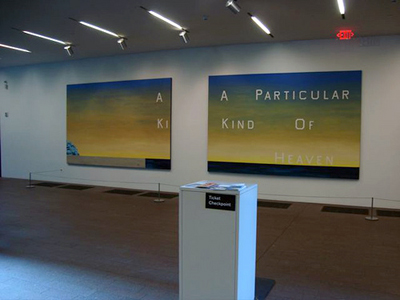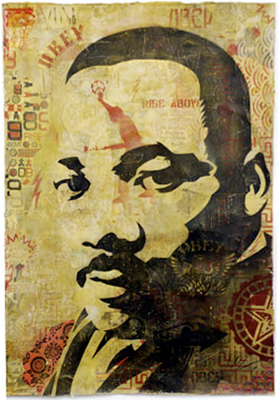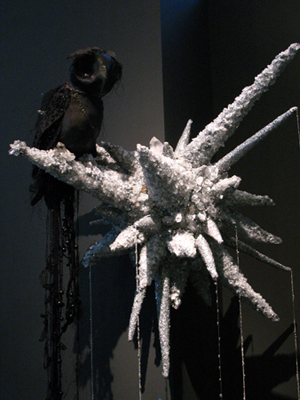I recently finished reading
Arts, Inc.: How Greed and Neglect Have Destroyed Our Cultural Rights by Bill Ivey, chairman of the NEA under the Clinton administration. The book is essentially Ivey's passionate argument for why the arts should take a more important role in American public policy.
There are a lot of interesting points of history and policy in this book, but the main question that it raises is how we can measure the value of the arts in our lives.
 Ed Ruscha, "A Particular Kind of Heaven," at San Francisco's de Young
Ed Ruscha, "A Particular Kind of Heaven," at San Francisco's de YoungIvey is particularly interested in persuading his readers that the pursuit of an "expressive life" - our right to both experience and produce art - is inherently American. The expressive life, Ivey argues, is an essential part of the constitutionally protected right to the
pursuit of happiness. Therefore the practice and consumption of arts should be a fundamental freedom that is guarded and encouraged by government policy.
Ivey opens the book with a Cultural Bill of Rights - not to be literally entered into law, but to guide our pursuit of personal freedom through creativity. This is worth re-posting:
Bill Ivey, "The Cultural Bill of Rights"
1. The right to our heritage - the right to explore music, literature, drama, painting, and dance that define both our nation's collective experience and our individual and community traditions.
2. The right to the prominent presence of artists in public life - through their art and the incorporation of their voices and artistic visions into democratic debate.
3. The right to an artistic life - the right to the knowledge and skills needed to play a musical instrument, draw, dance, compose, design, or otherwise live a life of active creativity.
4. The right to be represented to the rest of the world by art that fairly and honestly communicates America's democratic values and ideals.
5. The right to know about and explore art of the highest quality and to the lasting truths embedded in those forms of expression that have survived, in many lands, through the ages.
6. The right to healthy arts enterprises that can take risks and invest in innovation while serving communities and the public interest.
I should clarify that Ivey makes it clear throughout the book that he is using a broad definition of art that extends from Old Master painting to folk dance to Beyoncé. By art he means creative expression, in a general sense, and I think that's an important element to his argument that it serves the greater social good to encourage arts and arts organizations. For Ivey, the category is neither exclusionary of the "low" or "popular" nor "high" or "difficult."
(One of the bones I have to pick with this book is his dismissal of the entire visual arts community as ivory-tower painters. Yes, painters, specifically. But, I suppose specialists of visual arts, music, performance, dance, etc. will all feel glossed over in a book that attempts to encompass them all. Also, he's more advocate than writer, or UC Berkeley Press needed to assign him a better editor.)
Back to my original question: What is the value of the arts? I think about this question in two ways. One is very personal. When I speak to a social worker, it is difficult not to see pursuing a career in arts administration as somehow frivolous, as though my love of art should be secondary to an apparently nobler service. (I think this question would be a lot easier to dismiss if I were a professional artist, which probably reflects my sense that the act of making art that can be successful in the world is in itself a nobler service.)
The other level is more social. As Ivey points out, American arts advocates often justify support for arts organizations and arts education as a means to another end: Studying music will make you better at math and engineering. Instinctively, I feel like art has intrinsic value, but how do you define or defend that claim in the face of, for example, rampant job and home loss?
This is, obviously, painfully relevant right now. We've all watched the arts become an easy target in the partisan battle over Obama's much-vaunted stimulus plan. For Republicans, the National Endowment for the Arts and its "checkered past" is too tempting a scapegoat in the tired culture wars. Republican nitpicking over a fraction of funding to a significant part of the American economy is unsurprising. What's been truly disappointing is the
rapid defection of many prominent Democrats.
The immediate arguments against cutting the NEA out of the stimulus package: The arts and art nonprofit communities supply a lot of jobs. Studies show that successful arts organizations have a high positive effect on local economies. In the New Deal, the Works Progress Administration contributed significantly to the history of American art by hiring artists to create public work.
But why are the arts are so expendable in the first place? Another current controversy in the arts world comes from the same assumption, that art is the first thing to go, like a body sacrificing its reproductive organs when it becomes malnourished: Brandeis University is eliminating the Rose Museum. (
Tyler Green on the issue.) The art museum is, I am fairly confident, as important as the library and the labs. It is part of the lifeblood of the university, and simply selling off the collection is a shockingly drastic measure.
I am less confident that the arts are as important as food, housing, and health care. I still think that the $50 million, one/seventeenth the total of the package, that the House approved for the arts should go to the arts. It will have a stimulating effect on the economy, it should be part of the stimulus bill. But in such a time of social and financial crisis, how do we formulate an argument for more attention to the arts, for a larger role for the arts in policy?
Ivey's constitutional argument falls short for me. If the arts are only important to American culture because they are required for the pursuit of happiness, then they must fall by the wayside when basic needs aren't being met.
That assertion starts to take form better when he gets into the dual nature of the expressive life: Being in touch with your cultural heritage, and having access to the skills and motivation to be an active amateur creator. What arises out of this is more than personal pleasure and satisfaction: It's community. An active arts community should be open and accessible to anyone. It is the foundation of culture, and it is also a positive social glue that brings people together in times of poverty and crisis.
I certainly haven't come to any conclusive answers to the question of valuing art, but I do think it is more than hedonism or narcissism.
Labels: art, culture, economy, heritage, nea, policy




